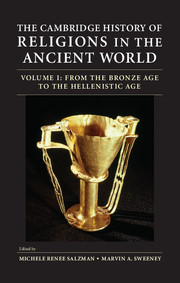Book contents
- Frontmatter
- Contents
- List of Figures and Maps
- List of Contributors
- List of Abbreviations
- Acknowledgments
- Introduction to Volumes I and II
- Introduction to Volume I
- Part I Mesopotamia and the Near East
- Part II Egypt and North Africa
- Part III Greece and the Eastern Mediterranean
- Part IV The Western Mediterranean and Europe
- Suggestions for Further Reading
- General Index
- Index of Citations
- Frontmatter
- Contents
- List of Figures and Maps
- List of Contributors
- List of Abbreviations
- Introduction to Volume II
- Part I Iran and the Near East
- 1 Religion in Iran
- 2 Creating Local Religious Identities in the Roman Near East
- 3 Judaism in Palestine in the Hellenistic-Roman Periods
- 4 Post-70 Judaism in Judea and the Near East
- 5 Christianity in Syria
- Part II Egypt and North Africa
- Part III Greece and Asia Minor
- Part IV Italy, Roman Gaul, and Spain
- Suggestions for Further Reading
- General Index
- Index of Citations
1 - Religion in Iran
The Parthian and Sasanian Periods (247 BCE–654 CE)
from Part I - Iran and the Near East
Published online by Cambridge University Press: 05 October 2013
- Frontmatter
- Contents
- List of Figures and Maps
- List of Contributors
- List of Abbreviations
- Acknowledgments
- Introduction to Volumes I and II
- Introduction to Volume I
- Part I Mesopotamia and the Near East
- Part II Egypt and North Africa
- Part III Greece and the Eastern Mediterranean
- Part IV The Western Mediterranean and Europe
- Suggestions for Further Reading
- General Index
- Index of Citations
- Frontmatter
- Contents
- List of Figures and Maps
- List of Contributors
- List of Abbreviations
- Introduction to Volume II
- Part I Iran and the Near East
- 1 Religion in Iran
- 2 Creating Local Religious Identities in the Roman Near East
- 3 Judaism in Palestine in the Hellenistic-Roman Periods
- 4 Post-70 Judaism in Judea and the Near East
- 5 Christianity in Syria
- Part II Egypt and North Africa
- Part III Greece and Asia Minor
- Part IV Italy, Roman Gaul, and Spain
- Suggestions for Further Reading
- General Index
- Index of Citations
Summary
Introduction
Rich in natural resources and strategically located at the crossroads of the ancient world’s civilizations, Iran has always been a sought-after prize for conquerors. Its history is thus one of both conquests and migrations, with many peoples and tribal federations entering the Iranian plateau in search of living space and pasture grounds. But human activity is only partly responsible for the great destruction that Iran has endured over its long history. Equally important are the earthquakes and other natural disasters that have engulfed the region periodically, often with devastating consequences, to which slow patterns of aridification and, locally, salination have further contributed. Given its complicated socio-ethnic and natural history, it is hardly surprising that the cultural and religious history of pre-Islamic Iran is difficult to write.
To understand the religious history of the region, we must also take account of the attitude toward writing shown by the Iranian peoples who dominated the area. When the Achaemenid Persians gained control of much of the ancient world, the flourishing civilizations that they encountered employed writing for various purposes: administration, scholarship, religion, and literature. While they retained local administrative practices in those parts of the empire that had a functioning bureaucracy (for example, Babylonia and Elam, the heart of the empire), the lingua franca of the new imperial bureaucracy was Aramaic. For this administration, they relied initially on Aramaean scribes, who eventually taught their craft to local, Iranian-speaking boys, especially in the outlying parts of the empire. This practice, already attested in the names of scribes found in a recently discovered fourth-century BCE archive from Bactria, is especially visible a few centuries later, after the conquests of Alexander and the collapse of Seleucid rule over Iran and Central Asia. Independently, some of the former provinces of the Achaemenid empire continued to use Aramaic scribal conventions, but this time in Iranian languages: Parthian, Sogdian, and Khwarezmian. We have to assume, therefore, that in the brief period of Macedonian and Seleucid rule over Iran, the traditional (Achaemenid) system of administration coexisted with a new administration in Greek.
- Type
- Chapter
- Information
- The Cambridge History of Religions in the Ancient World , pp. 23 - 53Publisher: Cambridge University PressPrint publication year: 2013



